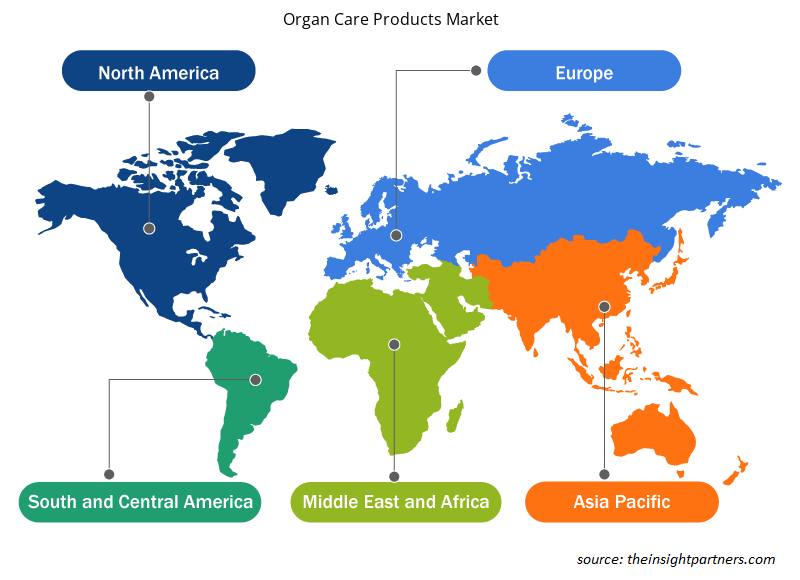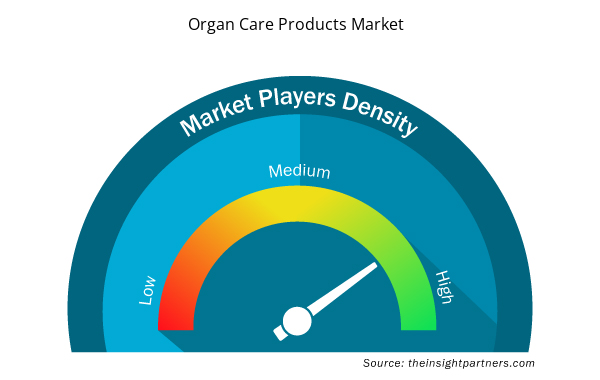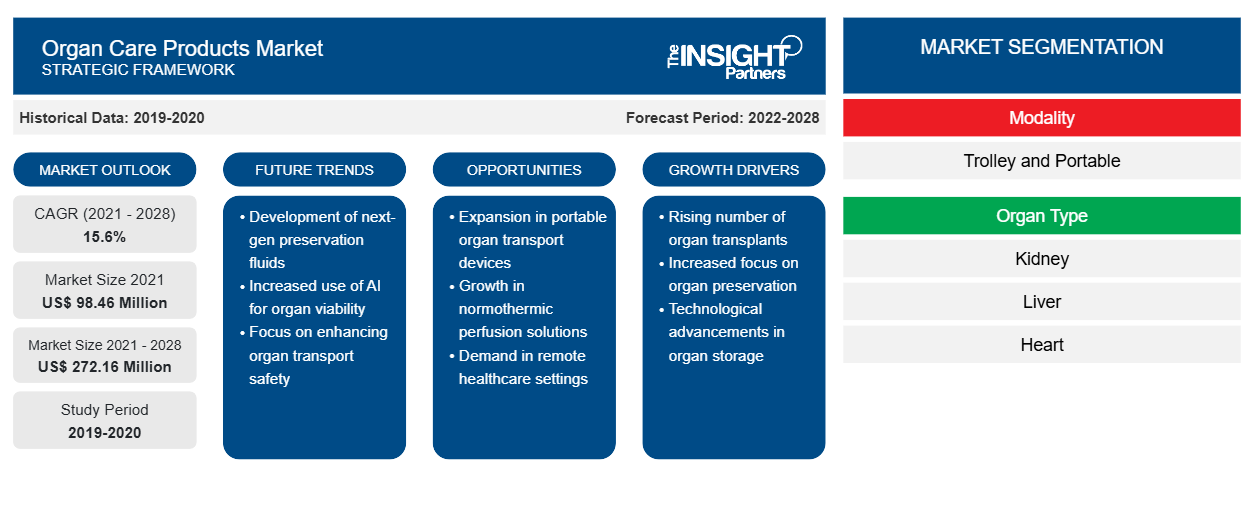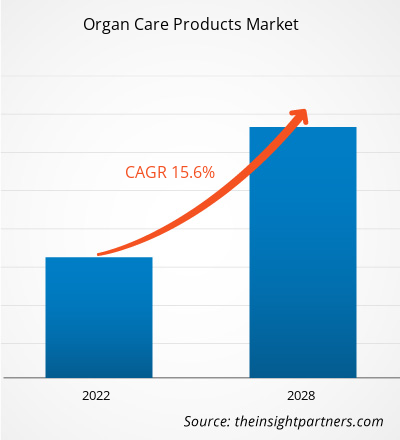[Forschungsbericht] Der Markt für Organpflegeprodukte soll von 98,46 Millionen US-Dollar im Jahr 2021 auf 272,16 Millionen US-Dollar im Jahr 2028 anwachsen; von 2021 bis 2028 wird mit einer durchschnittlichen jährlichen Wachstumsrate von 15,6 % gerechnet.
Ein Organpflegeprodukt ist ein medizinisches Gerät, das zur längeren Konservierung von Spenderorganen vor der Transplantation verwendet wird. Diese Verfahren ermöglichen es dem Transplantationsteam, sicherzustellen, dass die Transplantationsorgane optimal funktionieren. Es handelt sich um eine Technik, um transplantierte oder Spenderorgane bei einer sicheren Temperatur zu halten. „Herz in einer Box“ ist ein anderer Name für diese Technik. Vor der Transplantation werden die betreffenden Organe im bestmöglichen Zustand gehalten und sind vollständig handhabbar. Der Ansatz entspricht den traditionellen Systemen zur Konservierung von Organen durch Einfrieren oder Lagern in einer Umgebung und unter Bedingungen, die mit denen des menschlichen Körpers vergleichbar sind, indem das Blut des Spenders durch die Organe geleitet wird. Organe wie Niere, Leber, Herz und Lunge können mithilfe dieser Technologie überwacht werden, um sicherzustellen, dass sie optimal funktionieren. Organpflegeprodukte enthalten eine oder mehrere Pumpeneinheiten, Thermoeinheiten und Wagen.
Der Markt für Organpflegeprodukte ist nach Modalität, Organtyp, Endverbraucher und Geografie segmentiert. Geografisch ist der Markt grob in Nordamerika, Europa, Asien-Pazifik, den Nahen Osten und Afrika sowie Süd- und Mittelamerika unterteilt. Der Bericht über Organpflegeprodukte bietet Einblicke und eine eingehende Analyse des Marktes und betont Parameter wie Markttrends, technologische Fortschritte, Marktdynamik und die Wettbewerbsanalyse der weltweit führenden Marktteilnehmer.
Passen Sie diesen Bericht Ihren Anforderungen an
Sie erhalten kostenlos individuelle Anpassungen an jedem Bericht, einschließlich Teilen dieses Berichts oder einer Analyse auf Länderebene, eines Excel-Datenpakets sowie tolle Angebote und Rabatte für Start-ups und Universitäten.
- Holen Sie sich die wichtigsten Markttrends aus diesem Bericht.Dieses KOSTENLOSE Beispiel umfasst eine Datenanalyse von Markttrends bis hin zu Schätzungen und Prognosen.
Markteinblicke
Neue Produkteinführungen und Produktzulassungen im Bereich Organpflegeprodukte sollen den Markt für Organpflegeprodukte ankurbeln
Die steigende Nachfrage nach Organtransplantationen aufgrund von Organversagen hat den Bedarf an Organpflegeprodukten erhöht. Die sich schnell ändernde Dynamik des Gesundheitswesens und die steigende Prävalenz von Organversagen und -spenden haben die Nachfrage nach wirksamen Organpflegeprodukten geschaffen. Als Reaktion auf diese große Nachfrage konzentrieren sich verschiedene Marktteilnehmer darauf, bessere Organpflegeprodukte anzubieten, um die Marktnachfrage zu erfüllen. Darüber hinaus ermöglichen die Zulassungen solcher Produkte durch Aufsichtsbehörden die sichere Lagerung und den Transport von Spenderorganen über weite Entfernungen, was voraussichtlich zum Wachstum des Marktes für Organpflegeprodukte beitragen wird.
Im Folgenden finden Sie einige Beispiele für Unternehmen, die neue Produkte und Zulassungen für Organpflegeprodukte auf den Markt gebracht haben:
• Im Oktober 2021 hat Paragonix Technologies das LIVERguard Donor Liver Preservation System in den USA und Europa zusammen mit seinem globalen klinischen Register Global Utilization and Registry Database for Improved preservation of donor LIVERs (GUARDIAN-LIVER) klinisch und kommerziell auf den Markt gebracht. Das System wurde für eine konsistente und wiederholbare standardisierte Kaltlagerung von Lebern entwickelt, unabhängig von Zeit, Geografie oder unvorhergesehenen Bedingungen.
• Im September 2021 gab TransMedics Group, Inc. die Vorabzulassung der USFDA für sein OCS Liver System zur Organkonservierung nach DBD und DCD bekannt. Das System wird zur Erhaltung und Überwachung der Hämodynamik und der Stoffwechselfunktion eingesetzt und ermöglicht eine Ex-vivo-Beurteilung von Lebertransplantaten aus DBD- und DCD-Spenderlebern auf der Grundlage der OCS Liver PROTECT-Studie.
Solche Entwicklungen der Marktteilnehmer treiben den Markt für Organpflegeprodukte an.
Modalitätseinblicke
Basierend auf der Modalität ist der globale Markt für Organpflegeprodukte in Trolleys und tragbare Geräte unterteilt. Im Jahr 2021 hielt das Trolley-Segment einen größeren Marktanteil. Darüber hinaus wird erwartet, dass das tragbare Segment im Zeitraum 2021–2028 eine höhere durchschnittliche jährliche Wachstumsrate auf dem Markt verzeichnet. Dies ist hauptsächlich auf die Bequemlichkeit und Kompaktheit der Organpflegeprodukte zurückzuführen. Die tragbaren Geräte helfen dabei, die Zeit während der Organlagerung zu verwalten und die Organqualität zu verbessern.
Einblicke in Organtypen
Basierend auf dem Organtyp ist der globale Markt für Organpflegeprodukte in Nieren, Leber, Herz, Lunge und andere unterteilt. Im Jahr 2021 hatte das Nierensegment den größten Marktanteil. Es wird jedoch erwartet, dass das Lungensegment zwischen 2021 und 2028 die höchste durchschnittliche jährliche Wachstumsrate verzeichnet. Das Wachstum des Nierensegments ist auf die steigende Zahl von Nierenversagen zurückzuführen, die zu einer enormen Zahl von Patienten auf Wartelisten führt. Laut den Daten der Health Resources & Services Administration benötigten im Jahr 2020 in den USA fast 91.099 Patienten eine Nierentransplantation. Mit der wachsenden Zahl von Patienten, die an chronischen Erkrankungen leiden, wird die Nachfrage nach Organpflegeprodukten in den kommenden Jahren steigen.
Erkenntnisse für Endbenutzer
Basierend auf dem Endverbraucher ist der globale Markt für Organpflegeprodukte in Krankenhäuser, ambulante chirurgische Zentren und andere unterteilt. Im Jahr 2021 hielt das Krankenhaussegment den größten Marktanteil. Darüber hinaus wird erwartet, dass dasselbe Segment zwischen 2021 und 2028 die höchste durchschnittliche jährliche Wachstumsrate (CAGR) auf dem Markt verzeichnet. Die weltweit zunehmende Zahl von Organversagen, die zu Organtransplantationen führt, treibt das Segment an. Laut OPTN-Daten beliefen sich die Gesamtzahl der Transplantationen von 1998 bis Januar 2022 auf 881.082. 518.946 waren Nierentransplantationen, 191.894 Lebertransplantationen und 83.643 waren unter anderem Herztransplantationen.
Produkteinführungen und Kooperationen sind bei den Akteuren auf dem globalen Markt für Organpflegeprodukte weit verbreitete Strategien. Nachfolgend sind einige der jüngsten wichtigen Marktentwicklungen aufgeführt:
Im Februar 2021 fusionierten Bridge to Life, Ltd. und Tevosol, Inc., um bahnbrechende neue Produkte für die Organtransplantationsgemeinschaft zu entwickeln und zu vermarkten. Die Vereinbarung umfasst das erhebliche finanzielle Engagement von Bridge to Life zur Herstellung, Erprobung und Markteinführung von Tevosols tragbarer Ex-vivo-Lungenperfusionsmaschine (EVLP) und normothermer Organkonservierungsplattform.
Im Juni 2019 gab TransMedics die zweite FDA-PMA-Zulassung für sein OCS-Lungensystem bekannt. Dadurch wird der Zugriff auf einen größeren Pool von Spenderlungen ermöglicht, die derzeit aufgrund von Einschränkungen bei der Kühllagerung selten für Transplantationen verwendet werden.
Die COVID-19-Pandemie hat die Organspende und -transplantation weltweit stark beeinträchtigt und die Durchführung lebensrettender Verfahren wie Organtransplantationen beeinträchtigt, indem sie den Prozess der Organspende und -entnahme verändert hat. Darüber hinaus hat sie die Spenden- und Transplantationsaktivitäten weltweit unterbrochen, was zu einem Rückgang der Nachfrage nach Organpflegeprodukten geführt hat. Die Transplantationen von verstorbenen Spendern wurden auf dringende Fälle beschränkt, und Transplantationen von Lebendspenden wurden auf Eis gelegt. Dies führte zu verpassten Chancen für eine große Zahl gefährdeter Patienten auf Wartelisten für Transplantationen. Darüber hinaus wurden ein Rückgang der Zahl potenzieller verstorbener Organspender, eine Überlastung der Gesundheitssysteme und Intensivstationskapazitäten, ein eingeschränkter Zugang zu Tests für Spender und Empfänger auf die Infektion sowie Herausforderungen bei der Reise-/Transportlogistik für Entnahmeteams und gespendete Organe beobachtet. Dies wirkte sich während der Pandemie negativ auf den Markt aus.
Allerdings führte die Pandemie zur Einführung neuer Verfahren für eine angemessene Spenderevaluierung und -einwilligung, die Organentnahme und die Organisation der Organbeschaffung, was dem Markt in Zukunft zu einem erheblichen Wachstum verhelfen wird.
Regionale Einblicke in den Markt für Organpflegeprodukte
Die regionalen Trends und Faktoren, die den Markt für Organpflegeprodukte während des Prognosezeitraums beeinflussen, wurden von den Analysten von Insight Partners ausführlich erläutert. In diesem Abschnitt werden auch die Marktsegmente und die Geografie von Organpflegeprodukten in Nordamerika, Europa, im asiatisch-pazifischen Raum, im Nahen Osten und Afrika sowie in Süd- und Mittelamerika erörtert.

- Erhalten Sie regionale Daten zum Markt für Organpflegeprodukte
Umfang des Marktberichts zu Organpflegeprodukten
| Berichtsattribut | Details |
|---|---|
| Marktgröße im Jahr 2021 | 98,46 Millionen US-Dollar |
| Marktgröße bis 2028 | 272,16 Millionen US-Dollar |
| Globale CAGR (2021 - 2028) | 15,6 % |
| Historische Daten | 2019-2020 |
| Prognosezeitraum | 2022–2028 |
| Abgedeckte Segmente | Nach Modalität
|
| Abgedeckte Regionen und Länder | Nordamerika
|
| Marktführer und wichtige Unternehmensprofile |
|
Marktteilnehmerdichte für Organpflegeprodukte: Auswirkungen auf die Geschäftsdynamik verstehen
Der Markt für Organpflegeprodukte wächst rasant, angetrieben durch die steigende Nachfrage der Endverbraucher aufgrund von Faktoren wie sich entwickelnden Verbraucherpräferenzen, technologischen Fortschritten und einem größeren Bewusstsein für die Vorteile des Produkts. Mit steigender Nachfrage erweitern Unternehmen ihr Angebot, entwickeln Innovationen, um die Bedürfnisse der Verbraucher zu erfüllen, und nutzen neue Trends, was das Marktwachstum weiter ankurbelt.
Die Marktteilnehmerdichte bezieht sich auf die Verteilung der Firmen oder Unternehmen, die in einem bestimmten Markt oder einer bestimmten Branche tätig sind. Sie gibt an, wie viele Wettbewerber (Marktteilnehmer) in einem bestimmten Marktraum im Verhältnis zu seiner Größe oder seinem gesamten Marktwert präsent sind.
Die wichtigsten auf dem Markt für Organpflegeprodukte tätigen Unternehmen sind:
- TransMedics
- Bridge to Life GmbH
- Paragonix Technologies, Inc
- OrganOx Limited
- Waters Medical Systems LLC
Haftungsausschluss : Die oben aufgeführten Unternehmen sind nicht in einer bestimmten Reihenfolge aufgeführt.

- Überblick über die wichtigsten Akteure auf dem Markt für Organpflegeprodukte
Organpflegeprodukte – Marktsegmentierung
Der globale Markt für Organpflegeprodukte ist nach Modalität, Organtyp, Endverbraucher und Geografie segmentiert. In Bezug auf die Modalität ist der Markt in Trolleys und tragbare Geräte unterteilt. Basierend auf dem Organtyp ist der Markt für Organpflegeprodukte in Niere, Leber, Herz, Lunge und andere unterteilt. In Bezug auf den Endverbraucher ist der Markt für Organpflegeprodukte in Krankenhäuser, ambulante chirurgische Zentren und andere unterteilt. Geografisch ist der Markt in Nordamerika, Europa, Asien-Pazifik, den Nahen Osten und Afrika sowie Süd- und Mittelamerika unterteilt.
Firmenprofile
- TransMedics
- XVIVO Perfusion
- Bridge to Life GmbH
- Paragonix Technologies, Inc
- OrganOx Limited
- Waters Medical Systems LLC
- Organrückgewinnungssysteme
- Accord-Gesundheitswesen
- Dr. Franz Koehler Chemie GmbH
- Preservation Solutions, Inc.
- Historische Analyse (2 Jahre), Basisjahr, Prognose (7 Jahre) mit CAGR
- PEST- und SWOT-Analyse
- Marktgröße Wert/Volumen – Global, Regional, Land
- Branche und Wettbewerbsumfeld
- Excel-Datensatz



Report Coverage
Revenue forecast, Company Analysis, Industry landscape, Growth factors, and Trends

Segment Covered
This text is related
to segments covered.

Regional Scope
North America, Europe, Asia Pacific, Middle East & Africa, South & Central America

Country Scope
This text is related
to country scope.
Häufig gestellte Fragen
The factors that are driving the growth of market are rising incidences of organ failure & transplant procedures and new product launches and approvals of organ care products are expected to fuel the growth of the market. However, the high cost of organ transplantation & cultural barriers is the major factor hindering the market growth.
The organ care products market majorly consists of the players such as TransMedics; XVIVO Perfusion AB; Bridge to Life; Paragonix Technologies, Inc; OrganOx Limited; Preservation Solution, Inc.; Accord Healthcare; Dr. Franz Koehler Chemie GmbH; Waters Medical Systems LLC; Organ Recovery Systems, Inc. among others.
The organ care products market is analyzed in the basis of modality, organ type, and end user. Based on modality, the market is segmented into trolley and portable. The trolley segment held the largest share of the market, and portable segment is anticipated to register the highest CAGR. Based organ type, the market is segmented as kidney, heart, liver, lungs, and others. The kidney segment held the largest share of the market, and lungs segment is estimated to register the highest CAGR. And based on end user, the market is divided into hospitals, ambulatory surgical centers, and others. The hospitals segment held the largest share of the market, and it is estimated to register the highest CAGR.
The organ care products market is expected to grow at 16.4% over the forecast period.
North America accounts for the major market share of organ care products market in 2021.
Asia Pacific is expected to be the fastest growing region in organ care products market over the forecast period.
Organ care products are medical devices designed to store donated organs for longer periods while still providing the organ with the necessary nutrients. These devices are used to keep organs safe for a set amount of time before transplantation. This technology assists in monitoring organs such as the kidney, liver, to ensure that they are operating at their best. Organ care products contain one or more pump units, thermo units, and trolleys.
Trends and growth analysis reports related to Life Sciences : READ MORE..
The List of Companies - Organ Care Products Market
- TransMedics
- Bridge to Life Ltd
- Paragonix Technologies, Inc
- OrganOx Limited
- Waters Medical Systems LLC
- Organ Recovery Systems
- Accord Healthcare
- Dr. Franz Koehler Chemie GmbH
- Preservation Solutions, Inc.
- XVIVO Perfusion
The Insight Partners performs research in 4 major stages: Data Collection & Secondary Research, Primary Research, Data Analysis and Data Triangulation & Final Review.
- Data Collection and Secondary Research:
As a market research and consulting firm operating from a decade, we have published and advised several client across the globe. First step for any study will start with an assessment of currently available data and insights from existing reports. Further, historical and current market information is collected from Investor Presentations, Annual Reports, SEC Filings, etc., and other information related to company’s performance and market positioning are gathered from Paid Databases (Factiva, Hoovers, and Reuters) and various other publications available in public domain.
Several associations trade associates, technical forums, institutes, societies and organization are accessed to gain technical as well as market related insights through their publications such as research papers, blogs and press releases related to the studies are referred to get cues about the market. Further, white papers, journals, magazines, and other news articles published in last 3 years are scrutinized and analyzed to understand the current market trends.
- Primary Research:
The primarily interview analysis comprise of data obtained from industry participants interview and answers to survey questions gathered by in-house primary team.
For primary research, interviews are conducted with industry experts/CEOs/Marketing Managers/VPs/Subject Matter Experts from both demand and supply side to get a 360-degree view of the market. The primary team conducts several interviews based on the complexity of the markets to understand the various market trends and dynamics which makes research more credible and precise.
A typical research interview fulfils the following functions:
- Provides first-hand information on the market size, market trends, growth trends, competitive landscape, and outlook
- Validates and strengthens in-house secondary research findings
- Develops the analysis team’s expertise and market understanding
Primary research involves email interactions and telephone interviews for each market, category, segment, and sub-segment across geographies. The participants who typically take part in such a process include, but are not limited to:
- Industry participants: VPs, business development managers, market intelligence managers and national sales managers
- Outside experts: Valuation experts, research analysts and key opinion leaders specializing in the electronics and semiconductor industry.
Below is the breakup of our primary respondents by company, designation, and region:

Once we receive the confirmation from primary research sources or primary respondents, we finalize the base year market estimation and forecast the data as per the macroeconomic and microeconomic factors assessed during data collection.
- Data Analysis:
Once data is validated through both secondary as well as primary respondents, we finalize the market estimations by hypothesis formulation and factor analysis at regional and country level.
- Macro-Economic Factor Analysis:
We analyse macroeconomic indicators such the gross domestic product (GDP), increase in the demand for goods and services across industries, technological advancement, regional economic growth, governmental policies, the influence of COVID-19, PEST analysis, and other aspects. This analysis aids in setting benchmarks for various nations/regions and approximating market splits. Additionally, the general trend of the aforementioned components aid in determining the market's development possibilities.
- Country Level Data:
Various factors that are especially aligned to the country are taken into account to determine the market size for a certain area and country, including the presence of vendors, such as headquarters and offices, the country's GDP, demand patterns, and industry growth. To comprehend the market dynamics for the nation, a number of growth variables, inhibitors, application areas, and current market trends are researched. The aforementioned elements aid in determining the country's overall market's growth potential.
- Company Profile:
The “Table of Contents” is formulated by listing and analyzing more than 25 - 30 companies operating in the market ecosystem across geographies. However, we profile only 10 companies as a standard practice in our syndicate reports. These 10 companies comprise leading, emerging, and regional players. Nonetheless, our analysis is not restricted to the 10 listed companies, we also analyze other companies present in the market to develop a holistic view and understand the prevailing trends. The “Company Profiles” section in the report covers key facts, business description, products & services, financial information, SWOT analysis, and key developments. The financial information presented is extracted from the annual reports and official documents of the publicly listed companies. Upon collecting the information for the sections of respective companies, we verify them via various primary sources and then compile the data in respective company profiles. The company level information helps us in deriving the base number as well as in forecasting the market size.
- Developing Base Number:
Aggregation of sales statistics (2020-2022) and macro-economic factor, and other secondary and primary research insights are utilized to arrive at base number and related market shares for 2022. The data gaps are identified in this step and relevant market data is analyzed, collected from paid primary interviews or databases. On finalizing the base year market size, forecasts are developed on the basis of macro-economic, industry and market growth factors and company level analysis.
- Data Triangulation and Final Review:
The market findings and base year market size calculations are validated from supply as well as demand side. Demand side validations are based on macro-economic factor analysis and benchmarks for respective regions and countries. In case of supply side validations, revenues of major companies are estimated (in case not available) based on industry benchmark, approximate number of employees, product portfolio, and primary interviews revenues are gathered. Further revenue from target product/service segment is assessed to avoid overshooting of market statistics. In case of heavy deviations between supply and demand side values, all thes steps are repeated to achieve synchronization.
We follow an iterative model, wherein we share our research findings with Subject Matter Experts (SME’s) and Key Opinion Leaders (KOLs) until consensus view of the market is not formulated – this model negates any drastic deviation in the opinions of experts. Only validated and universally acceptable research findings are quoted in our reports.
We have important check points that we use to validate our research findings – which we call – data triangulation, where we validate the information, we generate from secondary sources with primary interviews and then we re-validate with our internal data bases and Subject matter experts. This comprehensive model enables us to deliver high quality, reliable data in shortest possible time.


 Holen Sie sich ein kostenloses Muster für diesen Bericht
Holen Sie sich ein kostenloses Muster für diesen Bericht